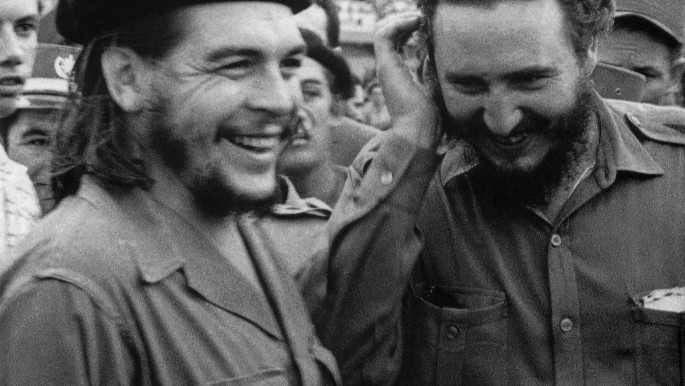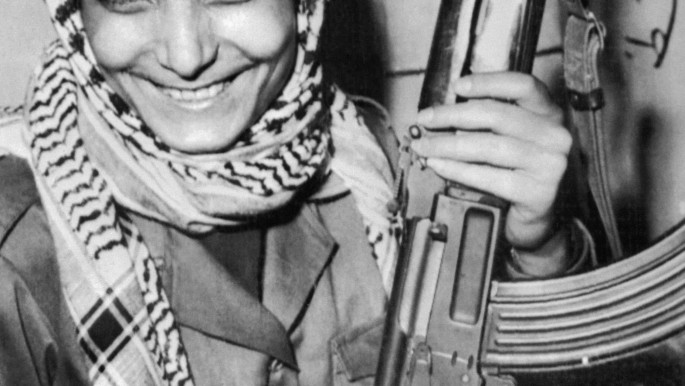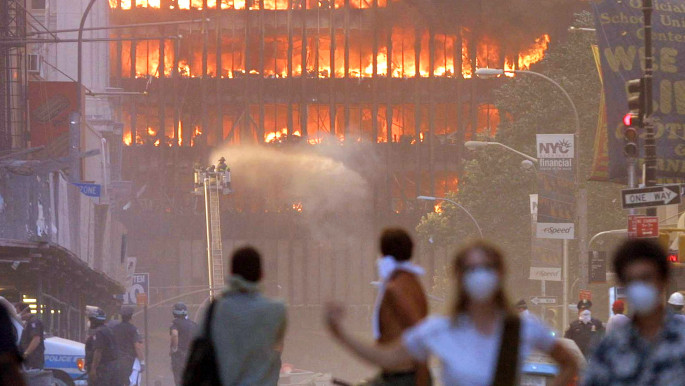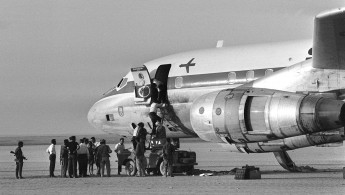Terror in the skies: Skyjacking and sabotage through history
Terror in the skies: Skyjacking and sabotage through history
From as early as the 1930s, aeroplanes have been the target of criminals and terrorists hoping to make their messages known
4 min read
A Swissair plane hijacked by members of the PFLP, September 1970 [AFP]
The advent of air travel was perhaps one of the most remarkable feats achieved in the early twentieth century. This amazing achievement, however, would soon make for a horrifyingly spectacular means for terrorists and criminals to gain leverage for their own ends.
From commandeering planes to alternative destinations, to crashing airliners into world famous landmarks, the use of planes as tools for political continues to pose a huge concern for travellers and security authorities around the world.
An unlucky helmsman
The world's first recorded hijacking of an aircraft happened in 1931, when American pilot Byron Rickards flew his two-passenger ford-trimotor into the Peruvian city of Arequipa. Upon landing, the pilot found himself surrounded by armed revolutionaries who demanded that he facilitate their transport or help to drop propaganda over cities in Peru.
Rickards bravely refused his captors' requests, and was held for ten days in the former Peruvian capital. He was later freed by the rebels when they informed him that their uprising had been successful.
Following this incident, the world saw a rise in the number of aeroplanes commandeered and attacked for political and criminal purposes.
 |
|
| Some early plane hijackings in the US were linked to communist sympathisers. [Pictured: Cuban Prime Minister Fidel Castro (Right) and Ernesto Che Guevara (left) [AFP] |
In this second hijacking, the Rickards complied and redirected Continental Airlines flight 54 to Cuba, however was rescued by FBI agents who shot the planes tyres as it stopped to refuel in El Paso, Texas.
The spate of hijackings in the early sixties led to the rollout of new security measures in the United States under the supervision of the Federal Aviation Administration's Syrian-Lebanese chief Najeeb Halaby.
Prior to this, security checks at airports were minimal, with passengers boarding flights unchecked.
Black September
With an early focus of some early hijackings on communist South America, September 1970 saw conflicts in the Middle East send ripples into the world of commercial aviation.
On September 6, armed supporters of the Popular Front for the Liberation of Palestine (PFLP) coordinated the hijackings of three jetliners flying from European cities to the US.
 |
|
| Palestinian PFLP hijacker Leila Khaled [AFP] |
TWA flight 741 from Frankfurt and Swiss Air flight 100 from Zurich, both of which were New York-bound, were diverted to an abandoned airfield in the Jordanian desert.
PFLP hijackers seized another plane three days later and diverted it to the same landing strip, which became known as Revolution Field.
The 421 passengers and crewmembers were released over two days, although the Jewish travellers were kept behind for release on the second day. The three empty planes were then blown up.
Another seizure of a plane, El Al Flight 219 from Amsterdam, was prevented after hijacker Patrick Arguello was shot and his accomplice Leila Khaled apprehended.
Arguello and Khaled were not alone, however, as two of their collaborators had failed to board. Eager to carry out their mission, they then took command of Pan Am flight 93, diverting the flight to Beirut and eventually to Cairo.
The plane was later evacuated safely, with the conspirators handed over to Egyptian authorities.
September 11, 2001
Still within recent memory are the tragic events of September 11 2001, when terror group al-Qaeda coordinated four attacks on buildings in the United States.
Four domestic passenger airliners were hijacked by 19 al-Qaeda terrorists from airports on the country's east coast. American Airlines flight 11 and United Airlines Flight 175 were crashed into the Twin Towers of the World Trade Centre in New York.
The towers, which rose at over 400 metres each, both collapsed within an hour and 42 minutes.
The third plane was flown into the Pentagon, the US Defence Department's headquarters, and the fourth airliner crashed into a field.
 |
| The 9/11 attacks on the World Trade centre engulfed parts of downtown Manhattan, New York city in smoke and dust [Getty] |
The US response to this catastrophic event was to launch its global War on Terror, which continues to this day and has claimed around 1.3 million lives worldwide.
The Islamic State group
The recent rise of the Islamic State [IS] group and their self-proclaimed caliphate has heightened global security efforts and concerns about commercial airliners.
In November 2015, the group claimed responsibility for the bombing of a Russian airliner travelling from Egypt, in which all 224 passengers were killed.
It was claimed that an IS operative smuggled a bomb disguised as a soft drink onto the plane.
Like the acts of sabotage and hijacking by al-Qaeda in the past, the IS group's attacks on aeroplanes were without specific demands, aimed simply at generating a climate of terror and fear.
With the militant group still holding territories in the Middle East and attracting some sympathisers from around the world, the IS group is often one of the first suspects when acts of terror are perpetrated against civil airliners today.



